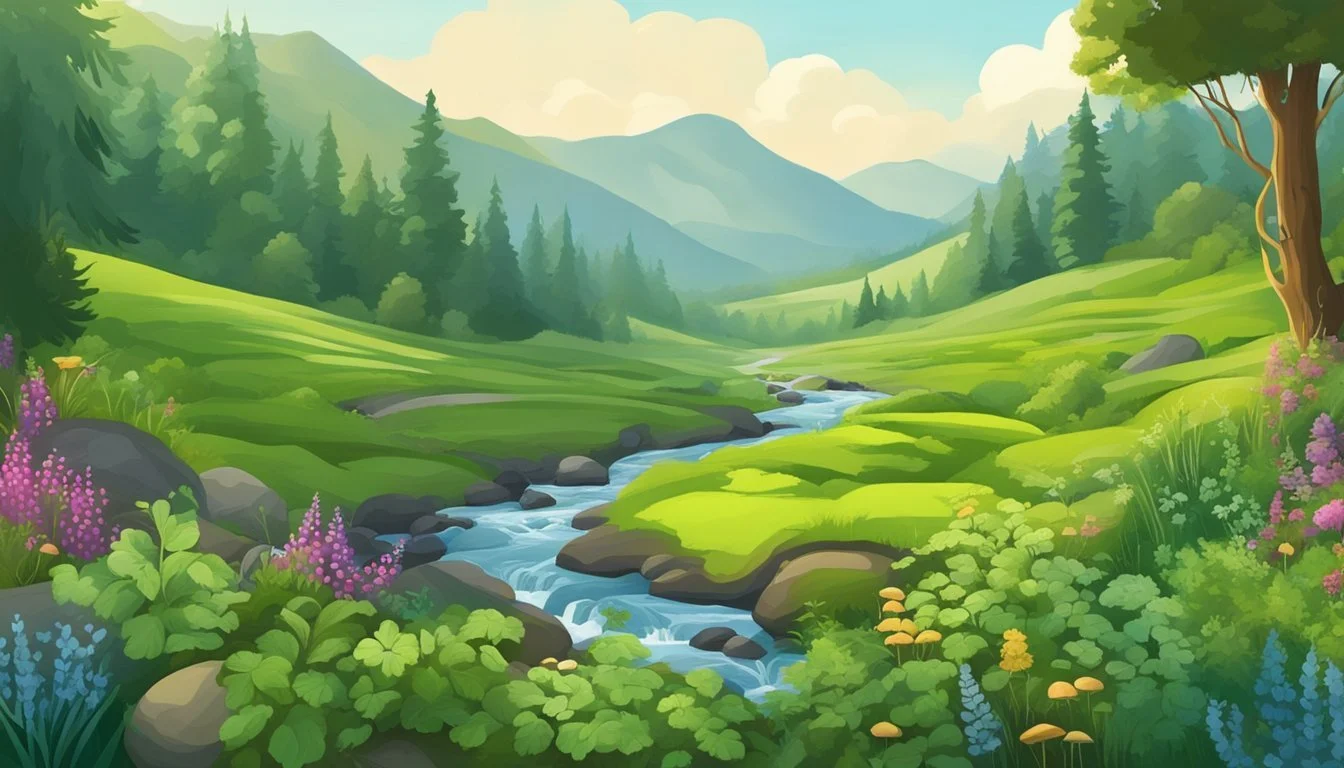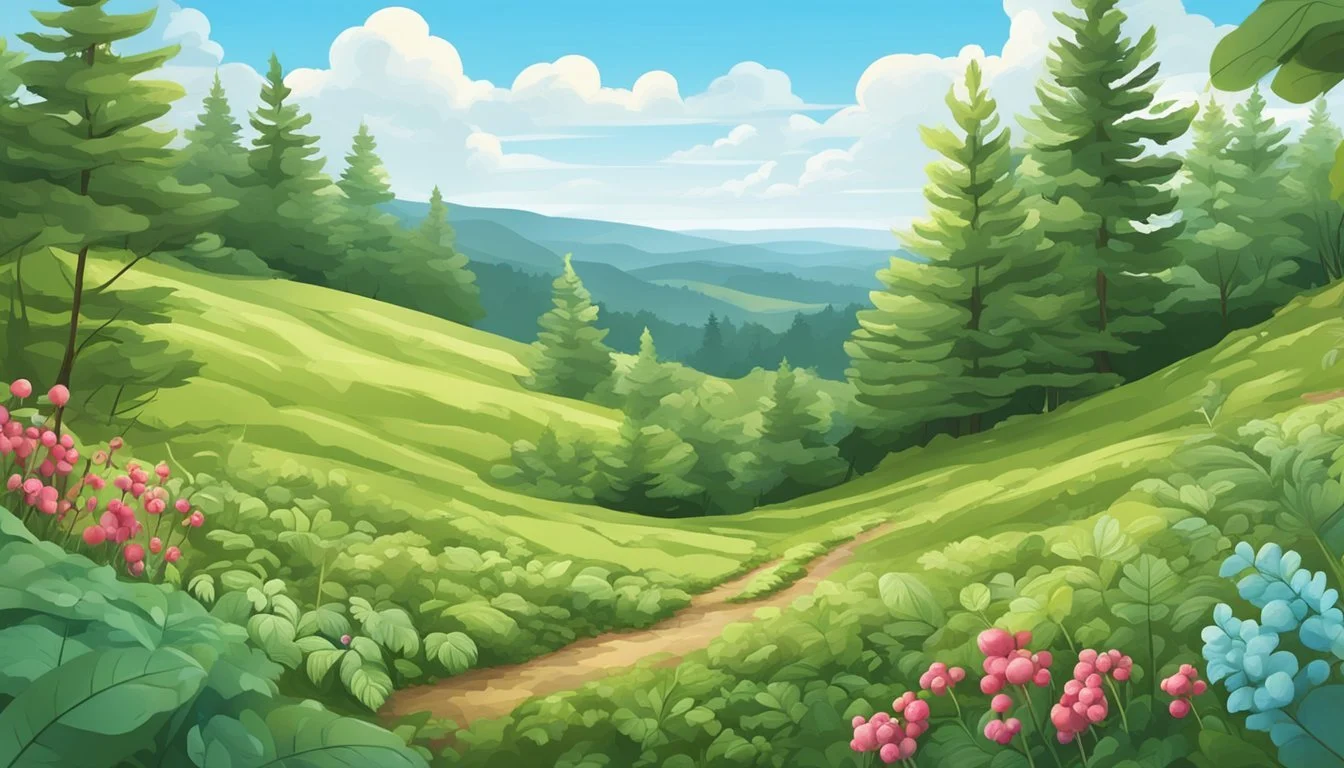Shenandoah Valley Native Edible Plants
A Guide to Local Foraging
Nestled in the heart of Virginia, the Shenandoah Valley is a treasure trove of native edible plants that sustain both local wildlife and human inhabitants. From the nutrient-rich blackberries that dot the landscape to the versatile Jerusalem artichokes, these native species offer a bounty of flavors and health benefits. Exploring the Shenandoah Valley's native edible plants reveals a diverse ecosystem where each plant plays a crucial role in maintaining ecological balance.
In the Shenandoah Valley, native plants like pawpaw and wild asparagus provide a sustainable and delicious food source. These plants are not only integral to the diet of local wildlife but also offer unique culinary possibilities for residents and visitors. By choosing to incorporate native species into their gardens and meals, individuals support the preservation of the valley’s natural heritage.
In addition to their ecological importance, native edible plants in the Shenandoah Valley can also be used for medicinal purposes. For instance, the roots of the purple coneflower have been traditionally used to boost the immune system. By appreciating and utilizing the native flora, one can contribute to a healthier environment and a richer culinary experience.
The Shenandoah Valley Ecosystem
The Shenandoah Valley, rich in biodiversity, is characterized by a variety of climatic conditions, soil types, and unique habitats. This region supports intricate interactions between wildlife and native plants, and is the focus of numerous conservation efforts, particularly by local plant societies.
Climatic Conditions
The climate in the Shenandoah Valley is marked by four distinct seasons, with cold winters and warm summers. Average annual rainfall ranges from 30 to 40 inches, supporting a wide range of plant and animal life. Elevation varies from around 300 to over 4,000 feet, influencing temperature and moisture levels across the valley.
Soil and Topography
Soil in the Shenandoah Valley is diverse, featuring limestone and shale-based soils that are fertile and support various vegetation types. The valley's topography includes rolling hills, forested mountains, and river valleys. These landscapes create micro-environments conducive to different plant communities and wildlife.
Distinctive Habitats
The valley boasts a mosaic of habitats, from deciduous forests and meadows to wetlands and barrens. Each habitat supports specific native plants and animal species. Forests, covering a large portion of the region, are populated with oaks, maples, and pines, while the meadows are rich with grasses and wildflowers.
Wildlife and Plant Interactions
Native plants play a crucial role in the ecosystem by providing food and shelter for mammals, birds, insects, and other pollinators. Mammals like deer, squirrels, and foxes are common. Birds, including songbirds and raptors, thrive here, often relying on native berries and seeds.
Conservation Efforts
Multiple agencies and organizations are dedicated to conserving the Shenandoah Valley's natural areas. These efforts include controlling invasive species, restoring native plant habitats, and educating the public about the importance of biodiversity. Programs often involve partnerships with local communities and environmental groups.
Native Plant Societies
The Virginia Native Plant Society, particularly its Shenandoah Chapter, plays a vital role in promoting native landscaping and conservation. They provide resources and guides, such as "Plants Ridge & Valley Natives," tailored to educate gardeners and land stewards about local flora and best practices.
Regional Flora
The Shenandoah Valley is home to diverse native plant species, including trees like the Eastern Redbud and White Oak, shrubs like Mountain Laurel, and numerous wildflowers such as Bluebells and Bloodroot. These species are adapted to the valley's climatic and soil conditions, making them essential to local ecosystems.
Common Threats
Invasive species, habitat loss, and climate change are major threats to the Shenandoah Valley's native plants and wildlife. Non-native species often outcompete native plants, disrupting local food webs. Efforts to mitigate these threats focus on habitat restoration and public awareness campaigns.
Indigenous Knowledge
Indigenous peoples have historically utilized the valley's plants for food, medicine, and materials. Their knowledge of native species is invaluable for modern conservation and sustainable practices. Traditional uses of plants include the Cherokee use of Blackberries for food and Wood Nettles for fiber.
Historical Use of Plants
Historically, settlers and local communities have relied on the valley's flora for sustenance and commerce. Native plants such as Sassafras, once used for root beer, and Ginseng, valued for its medicinal properties, played significant roles. This utilization underscores the ongoing importance of preserving native species.
Native Edible Plants Guide
Understanding the native edible plants of the Shenandoah Valley is crucial for both foragers and gardeners. It encompasses identifying plants, knowing their seasonal availability, nutritional values, and uses in cooking and remedies.
Identifying Edible Plants
Identifying native edible plants requires attention to detail. Key characteristics to observe include leaf shape, plant height, and flower color. For instance, the beaked hazelnut has yellow catkins and edible nuts. Salal features pink spring flowers and blue berries. Accurate identification is essential to avoid toxic look-alikes.
Seasonal Availability
Seasonal knowledge maximizes harvests. Springtime yields wild greens and herbs like wild mint and wood lily. Summer offers fruits such as blackberries and blueberries. Fall is prime for nuts like hickory and acorns. Knowing harvest times ensures fresh, nutrient-rich foraging.
Nutritional Values
Native plants are rich in nutrients. Hickory nuts are high in fats and proteins. Blueberries are packed with antioxidants. These plants contribute vitamins, minerals, and essential nutrients, making them valuable supplements to diets, especially in local and sustainable practices.
Herbal Remedies and Uses
Many native plants serve as herbal remedies. Wild licorice acts as a natural sweetener and is used for its medicinal properties. Yellow glacier-lily bulbs were traditionally used for various ailments. Understanding traditional and modern uses can enhance health benefits provided by these plants.
Culinary Uses
Native edible plants enrich culinary experiences. Allium peninsulare can spice up dishes with its mild onion-like flavor. Gaultheria shallon berries make excellent jams and sauces. Using native plants in cooking not only diversifies the palette but also supports local biodiversity.
Foraging Guidelines
Foraging should be done responsibly. Avoid over-harvesting to preserve plant populations. Only collect what is needed and ensure plant parts are removed without damaging the entire plant. Respect private properties and adhere to local regulations to maintain ethical foraging practices.
Popular Edible Plant Species
Popular species include the elderberry, known for its medicinal berries. Oak trees provide edible acorns, which can be processed into flour. Serviceberry produces sweet, edible fruits. These species are cherished for their practicality and culinary versatility.
Plant Harvesting and Conservation
Conservation is key when harvesting native plants. Use sustainable methods such as rotational harvesting. Avoid uprooting entire plants and focus on parts like leaves, stems, or fruits. Engage in projects like habitat restoration to sustain and protect native plant populations.
Edible Landscaping
Edible landscaping combines aesthetics with functionality. Incorporate shrubs like Gaultheria shallon for an evergreen hedge with edible berries. Plant hickory trees for shade and nut production. Using native plants in landscaping can create a beautiful and productive garden ecosystem.
Fruits, Seeds, and Nuts
Native plants offer a wide variety of fruits, seeds, and nuts. Wild roses provide edible rose hips. Hickory nuts are a nutritious food source. Yellowcress seeds can be used as a spice. These elements add rich flavors and nutritional benefits to diets while supporting local ecosystems.
Integration in Local Culture
The use of native edible plants in the Shenandoah Valley is deeply intertwined with local tradition, influencing both cuisine and community events. These practices highlight the rich heritage and promote sustainability.
Shenandoah Valley Cuisine
Native edible plants play a crucial role in Shenandoah Valley cuisine. Traditional recipes often incorporate local fruits and herbs, such as pawpaw, persimmon, and wild garlic.
These ingredients provide unique flavors and are valued for their nutritional benefits. Local chefs and home cooks alike embrace these plants, often showcasing them in dishes at restaurants and farmers' markets.
Several eateries highlight seasonal dishes featuring native plants, fostering a connection between the community and its culinary heritage. This emphasis on local ingredients supports sustainable farming and reduces reliance on non-native species.
Festivals and Educational Events
Festivals and educational events celebrating native plants are common in the Shenandoah Valley. These gatherings often feature workshops on identifying and cooking with native plants, providing valuable education to attendees.
Events such as the Shenandoah Valley Native Plant Festival highlight native fruits and herbs, offering tastings and cooking demonstrations.
Local organizations, like the Valley Conservation Council, often host talks and guided tours emphasizing the importance of native plants for the ecosystem. These events not only promote cultural heritage but also encourage sustainable practices within the community.
Participation in these activities helps preserve local traditions and educates the public on the benefits of using native plants in everyday life.
Gardening with Native Edibles
Gardening with native edibles offers numerous benefits, including supporting local wildlife, reducing the spread of invasive species, and creating a robust, self-sustaining garden. This section explores choosing the right plants, planning and maintaining your garden, and the additional benefits and challenges of native edible gardening.
Choosing the Right Species
Selecting appropriate native plants is crucial for a successful edible garden. Focus on species well-suited to the Shenandoah Valley's climate and soil.
Native Edibles to Consider:
Pawpaw (Asimina triloba): Known for its unique tropical flavor.
Persimmon (Diospyros virginiana): Produces sweet, flavorful fruit.
American Cranberry (Vaccinium macrocarpon): Requires moist, acidic soil.
It's essential to research specific growth requirements such as sunlight, moisture levels, and soil pH to ensure optimal plant health and productivity.
Design and Planning
Effective garden design and planning can maximize space and productivity. Start by mapping your garden and grouping plants with similar requirements.
Considerations:
Sunlight: Place sun-loving plants in the most exposed areas.
Water Needs: Group plants based on their moisture requirements.
Companion Planting: Improve growth and pest control by planting compatible species together.
Incorporate paths and access points to make harvesting and maintenance easier.
Maintenance and Care
Regular maintenance is key to a thriving native edible garden. This includes watering, pruning, and monitoring for pests.
Tips:
Mulching: Helps retain moisture and suppress weeds.
Pruning: Encourages healthy growth and increases fruit production.
Pest Management: Use organic methods to protect plants without harming beneficial insects.
Pay attention to plant health and make adjustments as needed to support vigorous growth.
Benefits of Native Gardening
Gardening with native plants provides several ecological and practical benefits.
Advantages:
Supports Wildlife: Native plants attract and sustain local wildlife, including pollinators.
Reduces Invasive Species: Cultivating native plants prevents the spread of non-native species.
Low Maintenance: These plants are adapted to local conditions, requiring less water and fertilizers.
By fostering a balanced ecosystem, your garden contributes to biodiversity and environmental health.
Community Gardening Projects
Community gardens can amplify the benefits of native edible gardening. They foster collaboration, education, and resource sharing.
Considerations:
Planning: Engage local authorities and community members early in the process.
Education: Offer workshops on native plants and sustainable practices.
Resource Sharing: Pool resources like tools, seeds, and compost.
These projects can strengthen community bonds and provide fresh, healthy produce for all involved.
Challenges and Solutions
Gardening with native edibles comes with challenges, such as finding the right plants and managing pests.
Common Challenges:
Plant Availability: Native plants may not be readily available at all nurseries.
Pest Control: Some native plants are more susceptible to local pests.
Solutions:
Specialty Nurseries: Seek out nurseries that specialize in native plants.
Integrated Pest Management (IPM): Use a combination of biological, mechanical, and chemical methods to manage pests.
Addressing these challenges proactively ensures a productive and sustainable garden.
Conservation and Sustainability
Effective conservation and sustainability are essential to preserving the native edible plants of the Shenandoah Valley. Efforts focus on environmental protection, sustainable practices, ecosystem support, policy advocacy, collaboration, and education.
Environmental Impact
The introduction and spread of invasive species pose a significant threat to native plants in the Shenandoah Valley. The replacement of native flora by invasive species disrupts local ecosystems and endangers indigenous wildlife. Native plants often serve as crucial food sources and habitats for local species. By prioritizing conservation efforts, it is possible to maintain biodiversity and ecological stability. Encouraging the growth of native plants also helps combat soil erosion, supports water retention, and sustains the overall health of the environment.
Sustainable Foraging Practices
Sustainable foraging involves harvesting plants in a manner that ensures their continued growth and reproduction. Foragers should identify plants accurately and collect only parts of a population to avoid overharvesting. Rotating foraging locations can minimize pressure on any single area. Responsible foraging includes leaving enough plants behind to reseed and sustain wildlife that depends on them. Education regarding sustainable foraging practices is critical to maintaining the availability of native edible plants for future generations.
Supporting Local Ecosystems
Cultivating and preserving native edible plants bolster local ecosystems by providing essential resources for wildlife. Birds, bees, butterflies, and mammals rely on these plants for nutrition and habitat. Native plants adapt better to local soil and climate conditions, thereby requiring fewer resources to thrive. Supporting local ecosystems through native plant use enhances resilience against climate change, promotes biodiversity, and reduces the need for chemical interventions, which can harm neighboring natural areas.
Advocacy and Protection Policies
Laws and policies play a pivotal role in the conservation of native plants. Advocacy efforts by organizations like the Virginia Native Plant Society and its Shenandoah chapter promote legal protections that help manage land use and prevent the spread of invasive species. Listening to experts and engaging in community action strengthen conservation initiatives. Public policy must focus on habitat preservation, sustainable agricultural practices, and stringent regulations on plant importation to safeguard native plant species.
Collaboration with Conservation Groups
Partnerships with conservation groups enhance the effectiveness of preservation efforts. Organizations such as the Valley Conservation Council work with local communities to protect scenic landscapes and biodiversity. These collaborations provide valuable resources and expertise, making it possible to create strategic plans for conservation. Cooperative efforts also facilitate larger-scale initiatives such as habitat restoration projects, invasive species control, and public engagement programs.
Educational Resources and Outreach
Education is fundamental to promoting the conservation of native edible plants. Workshops, publications, and outreach programs by groups like the Virginia Native Plant Society provide important knowledge to gardeners, landowners, and the general public. Educational initiatives spread awareness about the benefits of native plants and inspire collective responsibility for their preservation. Schools, community centers, and local events serve as platforms to disseminate information and encourage active participation in conservation.
By incorporating conservation and sustainability principles, the Shenandoah Valley can preserve its native edible plants, ensuring they remain an integral part of the region's natural heritage.
Appendix
A key component of understanding Shenandoah Valley's native edible plants involves familiarizing oneself with specific terms and concepts used in the context of ecology and botany.
Glossary of Terms
Native Plants
Plants that occur naturally in a specific region, ecosystem, or habitat without human introduction. They have evolved over thousands of years, adapting to local environmental conditions.
Pollination
The transfer of pollen from the male part of the plant (stamen) to the female part (pistil) which can result in the production of seeds and fruits.
Invasive Species
Non-native species that spread widely in a new environment and can cause harm to native species, ecosystems, or human activities.
Vascular Plants
Plants that have specialized tissue (xylem and phloem) for conducting water, minerals, and photosynthetic products throughout the plant. Examples include ferns, conifers, and flowering plants.
Ecological Landscape Design
A practice focusing on creating landscapes that replicate natural ecosystems, often incorporating a variety of native plants to support local wildlife and biodiversity.
Edible Plants
Plants whose parts like leaves, roots, fruits, or seeds are safe and nutritious for human consumption. In Shenandoah Valley, examples include wild berries and certain herbs.
Beneficial Insects
Insects that perform valuable services in the garden, such as pollination, pest control, and decomposition. Examples include bees, ladybugs, and butterflies.
Habitat
The natural environment where a plant or animal lives, which provides food, water, shelter, and space to grow and reproduce.
Biodiversity
The variety of life in a particular habitat or ecosystem. High biodiversity often indicates a healthy, resilient environment.







